Urquhart's Theorem - 2 Solutions From Leningrad Mathematical Olympiad
Urquhart's Theorem was a subject of problem 61 at the 55th Leningrad Mathematical Olympiad (1989) for grade 9. The problem, with two solutions, appeared in a collection that has been published by MathPro press. Below, I shall preserve the notations from the book, which are different from those used elsewhere at the site.
With a reference to the figure below, points M and N are chosen on the sides AB and BC of triangle ABC, respectively, so that

|
Solution 1
Denote angles MAO and NCO by letters α and β, respectively. Squaring the equality
| AM² + AN² - 2AM×AN cos α = CM² + CN² - 2CM×CN cos β |
(both sides of this equality are equal to MN²). So, we can obtain the important relation
| AM×AN(1 + cos α) = CM×CN(1 + cos β), |
which will be used later. We begin by focusing on segments AO, AB, CO, CR. The law of cosines for triangles AOB and BOC gives
| AO² + AB² - 2AO×AB cos α = CO² + CR² - 2CO×CB cos β. |
So, to obtain the desired equality
| AO×AB(1 + cos α) = CO×CB(1 + cos β) |
holds true. Thus, we must prove the equality
|
which will complete the solution. Let's write the law of sines for triangles AMO, NOC, ANB, BMC:
| AO / AM | = sin(∠AMO) / sin(∠AOM), | |
| CO / CN | = sin(∠ONC) / sin(∠NOC), | |
| BC / MC | = sin(∠BMC) / sin(∠MBC), | |
| AN / AR | = sin(∠MBC) / sin(∠BNA). |
Since sin(180° - x) = sin x, we see that
Solution 2
The key fact of the second solution is that both equalities
Fixed point N from segment BC determines the unique point M lying on segment AB such that pair M, N is right. It follows by observation that there exists a single circle inscribed in "triangle" XANY - its center is the intersection point of the bisectors of angles XAN and ANY.
Fixed point N from segment BC determines no more than one point M from segment AB that satisfies the equality
AM + AN = CM + CN.
Proof
Assuming there exist two such points M1 and M2, we have
| CM2 - CM1 = AM2 - AM1 = M2M1. |
But the triangle inequality applied to triangle CM2M1 gives
If points M, N lying on segments AB, BC, respectively, constitute a right pair, then
AM + AN = CM + CN.
Proof
Denote the points at which the inscribed circle touches the sides of the equilateral corresponding to this choice of M, N by the letters K, L, P, R. Then we have the equalities
| AM + AN | = MK - AK + AL + LN | |
| = MK + LN | ||
| = MP + NR | ||
| = MP + PC - CR + NR | ||
| = CM + CN. |
Now, these three statements imply that if equality
Thus, to complete the solution we have to prove that if points M, N form a right pair, then the equality
Note: Perhaps the second solution seems long, but this is caused by our attempt to supply an essentially geometric consideration. We'd like to stress the undoubted beauty of the idea of proving an equivalence of two given assertions using a third (not obvious) one, which is equivalent to each of them.
Reference
- D. Fomin, A. Kirichenko, Leningrad Mathematical Olympiads 1987-1991, MathPro Press, 1994
![]()
Urquhart's Theorem
- Urquhart's Theorem
- Proof by M. Cabart
- An elementary synthetic solution
- From Leningrad Mathematical Olympiad
- Pedoe's theorem
- Pitot theorem
![]()
|Contact| |Front page| |Contents| |Geometry|
Copyright © 1996-2018 Alexander Bogomolny73576058
